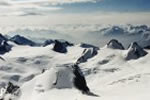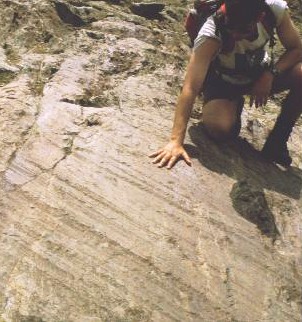


 |
 |
 |
Striations
When a glacier moves across the underlying rock, the process of abrasion wears it away. It is the fragments of rock held in the ice that do the abrading, scraping across the rock surface like nails across a wooden desk top. Larger rock fragments leave deep scratch marks behind them. These scratch marks are straight parallel lines that reveal the direction of ice movement.
Freshly exposed striations have a preferred orientation of rock grains. By lightly running a finger along the striation it is possible to discover that when moving one way along it, the rock feels smooth, but when moving the other way it feels more coarse. The moving ice leaves the rock grains aligned with the direction of movement, so when the striation feels smooth, your finger is moving in the direction of ice flow. When the striation feels rough, you are moving against the ice flow. This test doesn't always work, and wont work on striations that have been exposed for a long period of time.

In the picture above, Christopher is establishing the direction of ice movement by running his fingers over the striations. He decided that the ice had been moving from his right to his left, which was just as well since the glacier was still flowing in that direction the valley just below him!
Roche Moutonnee
Roche Moutonnee are outcrops of resistant bed rock with a gentle abraded slope on what would have been the upstream side of the ice (stoss slope) and a steep rougher slope on the downstream side (lee slope).
The name is French and translates literally into English as 'fleecy or sheep's wool rocks', but it usually interpreted as meaning 'sheep rocks'. The term was first used in 1776 by a French geologist, De Saussure, and later described by another famous French geologist, M de Lapparent, in 1883 who stated that such rocks "produce an impression like that of a flock of sleeping sheep, hence the name roche moutonée".This can sometimes be quite a good description of them when seen from a distance.
The smooth upstream slope is probably caused by abrasion as the ice advances over the rock, and the rough 'tail' is due to the action of plucking where ice has attached to the rock and literally pulled rock fragments away. Plucking could occur because as the ice moved up the stoss slope there was a reduction in pressure, allowing liquid water to re-freeze and attach the ice to the underlying rocks.
Crag and Tail
A crag and tail is a larger rock mass than a roche moutonnee. Like a roche moutonnee, it is formed from a section of rock that was more resistant than its surroundings. On the lee side of the resistant rock, the bed rock was protected from the erosional power of the glacier.
The volcanic rocks on which Edinburgh Castle (Scotland) is built provided protection against the erosion from an advancing glacier and Royal Mile, the main street in Edinburgh, extends along the gently downward sloping lee slope, or tail.
We value
your ideas and suggestions. Please contact the
maintainer of this site.
This page
can be found at: http://www.geography-site.co.uk
Last update to
this statement was on:
November 29, 2008
© Copyright Geography Site